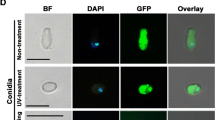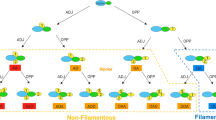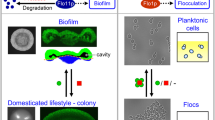Abstract
The RPS26A and RPS26B isogenes of Saccharomyces cerevisiae encode two almost identical proteins of the small 40S ribosomal subunit, which differ by only two amino acid residues. Growth of an rps26BΔ mutant strain is normal, whereas an rps26AΔ strain displays a reduced growth rate and increased sensitivity towards the specific translational inhibitor paromomycin. An rps26AΔ rps26BΔ double mutant strain is inviable. RPS26A but not RPS26B is required for haploid adhesive and diploid pseudohyphal growth mediated by FLO11, which encodes an adhesion. The RPS26A and RPS26B transcripts make up about 70 and 30% of the cellular RPS26 mRNA, respectively. Overexpression of RPS26B, as well as an RPS26B open reading frame driven by the RPS26A promoter, complements the rps26AΔ deletion and restores haploid invasive growth as well as diploid pseudohyphal growth. These results suggest that the two proteins are functionally interchangeable. FLO11–lacZ activity is not present in haploid rps26AΔ yeast mutant strains, even though FLO11 mRNA levels are not reduced. This suggests that the amount of Rps26p is critical for accurate translation of the FLO11 mRNA, and therefore for the dimorphic switch of the bakerȁ9s yeast from a single cell yeast to an adhesive filamentous growth form.







Similar content being viewed by others
References
Braus GH, Grundmann O, Brückner S, Mösch HU (2003) Amino acid starvation and Gcn4p regulate adhesive growth and FLO11 gene expression in Saccharomyces cerevisiae. Mol Biol Cell 14:4272–4284
Caro LH, Tettelin H, Vossen JH, Ram AF, van den Ende H, Klis FM (1997) In silicio identification of glycosyl-phosphatidylinositol-anchored plasma-membrane and cell wall proteins of Saccharomyces cerevisiae. Yeast 13:1477–1489
Carter AP, Clemons WM, Brodersen DE, Morgan-Warren RJ, Wimberly BT, Ramakrishnan V (2000) Functional insights from the structure of the 30S ribosomal subunit and its interactions with antibiotics. Nature 407:340–348
Cross FR, Tinkelenberg AH (1991) A potential positive feedback loop controlling CLN1 and CLN2 gene expression at the start of the yeast cell cycle. Cell 65:875–883
Cullen PJ, Sprague GF Jr (2000) Glucose depletion causes haploid invasive growth in yeast. Proc Natl Acad Sci USA 97:13619–13624
Dietrich FS et al (2004) The Ashbya gossypii genome as a tool for mapping the ancient Saccharomyces cerevisiae genome. Science 304:304–307
Gimeno CJ, Ljungdahl PO, Styles CA, Fink GR (1992) Unipolar cell divisions in the yeast S. cerevisiae lead to filamentous growth regulation by starvation, RAS. Cell 68:1077–1090
Gomez-Lorenzo MG et al (2000) Three-dimensional cryo-electron microscopy localization of EF2 in the Saccharomyces cerevisiae 80S ribosome at 17.5 A resolution. EMBO J 19:2710–2718
Green R, Noller HF (1997) Ribosomes and translation. Annu Rev Biochem 66:679–716
Guldener U, Heck S, Fielder T, Beinhauer J, Hegemann JH (1996) A new efficient gene disruption cassette for repeated use in budding yeast. Nucleic Acids Res 24:2519–2524
Guo B, Styles CA, Feng Q, Fink GR (2000) A Saccharomyces gene family involved in invasive growth, cell–cell adhesion, and mating. Proc Natl Acad Sci USA 97:12158–12163
Healy AM, Zolnierowicz S, Stapleton AE, Goebl M, DePaoli-Roach AA, Pringle JR (1991) CDC55, a Saccharomyces cerevisiae gene involved in cellular morphogenesis: identification, characterization, and homology to the B subunit of mammalian type 2A protein phosphatase. Mol Cell Biol 11:5767–5780
Ito H, Fukuda Y, Murata K, Kimura A (1983) Transformation of intact yeast cells treated with alkali cations. J Bacteriol 153:163–168
Jimenez A, Davies J (1980) Expression of a transposable antibiotic resistance element in Saccharomyces. Nature 287:869–871
Koc EC, Burkhart W, Blackburn K, Moseley A, Koc H, Spremulli LL (2000) A proteomics approach to the identification of mammalian mitochondrial small subunit ribosomal proteins. J Biol Chem 275:32585–32591
Lambrechts MG, Bauer FF, Marmur J, Pretorius IS (1996) Muc1, a mucin-like protein that is regulated by Mss10, is critical for pseudohyphal differentiation in yeast. Proc Natl Acad Sci USA 93:8419–8424
Liu H, Styles CA, Fink GR (1993) Elements of the yeast pheromone response pathway required for filamentous growth of diploids. Science 262:1741–1744
Lo WS, Dranginis AM (1998) The cell surface flocculin Flo11 is required for pseudohyphae formation and invasion by Saccharomyces cerevisiae. Mol Biol Cell 9:161–171
Madhani HD, Styles CA, Fink GR (1997) MAP kinases with distinct inhibitory functions impart signaling specificity during yeast differentiation. Cell 91:673–684
Mager WH et al (1997) A new nomenclature for the cytoplasmic ribosomal proteins of Saccharomyces cerevisiae. Nucleic Acids Res 25:4872–4875
Miozzari G, Niederberger P, Hutter R (1978) Tryptophan biosynthesis in Saccharomyces cerevisiae: control of the flux through the pathway. J Bacteriol 134:48–59
Mösch HU (2000) Pseudohyphal development of Saccharomyces cerevisiae. Contrib Microbiol 5:185–200
Mösch HU (2002) Pseudohyphal growth in yeast. In: Osiewacz HD (ed) Molecular biology of fungal development. Dekker, New York, pp 215–244
Mösch HU, Fink GR (1997) Dissection of filamentous growth by transposon mutagenesis in Saccharomyces cerevisiae. Genetics 145:671–684
Mösch HU, Kübler E, Krappmann S, Fink GR, Braus GH (1999) Crosstalk between the Ras2p-controlled mitogen-activated protein kinase and cAMP pathways during invasive growth of Saccharomyces cerevisiae. Mol Biol Cell 10:1325–1335
Mumberg D, Muller R, Funk M (1994) Regulatable promoters of Saccharomyces cerevisiae: comparison of transcriptional activity and their use for heterologous expression. Nucleic Acids Res 22:5767–5768
Myers AM, Tzagoloff A, Kinney DM, Lusty CJ (1986) Yeast shuttle and integrative vectors with multiple cloning sites suitable for construction of lacZ fusions. Gene 45:299–310
Palecek SP, Parikh AS, Kron SJ (2000) Genetic analysis reveals that FLO11 upregulation and cell polarization independently regulate invasive growth in Saccharomyces cerevisiae. Genetics 156:1005–1023
Planta RJ, Mager WH (1998) The list of cytoplasmic ribosomal proteins of Saccharomyces cerevisiae. Yeast 14:471–477
Roberts RL, Fink GR (1994) Elements of a single MAP kinase cascade in Saccharomyces cerevisiae mediate two developmental programs in the same cell type: mating and invasive growth. Genes Dev 8:2974–2985
Rose M, Botstein D (1983) Construction and use of gene fusions to lacZ (beta-galactosidase) that are expressed in yeast. Methods Enzymol 101:167–180
Rupp S, Summers E, Lo HJ, Madhani H, Fink G (1999) MAP kinase and cAMP filamentation signaling pathways converge on the unusually large promoter of the yeast FLO11 gene. EMBO J 18:1257–1269
Sherman F, Hicks J (1991) Micromanipulation and dissection of asci. Methods Enzymol 194:21–37
Sikorski RS, Hieter P (1989) A system of shuttle vectors and yeast host strains designed for efficient manipulation of DNA in Saccharomyces cerevisiae. Genetics 122:19–27
Southern EM (1975) Detection of specific sequences among DNA fragments separated by gel electrophoresis. J Mol Biol 98:503–517
Spahn CM et al (2001) Structure of the 80S ribosome from Saccharomyces cerevisiae—tRNA–ribosome and subunit–subunit interactions. Cell 107(3):373–386
Verschoor A, Warner JR, Srivastava S, Grassucci RA, Frank J (1998) Three-dimensional structure of the yeast ribosome. Nucleic Acids Res 26:655–661
Webster TD, Dickson RC (1983) Direct selection of Saccharomyces cerevisiae resistant to the antibiotic G418 following transformation with a DNA vector carrying the kanamycin-resistance gene of Tn903. Gene 26:243–252
Acknowledgements
We thank Sven Krappmann and Hans-Ulrich Mösch for their ideas and their support during the entire study period. We are grateful to Maria Meyer for her help in the tetrad dissection and to Brita Kotrasch and Elizabeth Dennison for critically reading of the manuscript. Furthermore, we would like to thank all members of our group for their helpful discussions. This work was supported by grants from the Deutsche Forschungsgemeinschaft, the Volkswagen-Stiftung and the Fonds der Chemischen Industrie.
Author information
Authors and Affiliations
Corresponding author
Additional information
Communicated by S. Hohmann
Axel W. Strittmatter and Claudia Fischer have contributed equally to this work.
Rights and permissions
About this article
Cite this article
Strittmatter, A.W., Fischer, C., Kleinschmidt, M. et al. FLO11 mediated filamentous growth of the yeast Saccharomyces cerevisiae depends on the expression of the ribosomal RPS26 genes. Mol Genet Genomics 276, 113–125 (2006). https://doi.org/10.1007/s00438-006-0127-7
Received:
Accepted:
Published:
Issue Date:
DOI: https://doi.org/10.1007/s00438-006-0127-7




